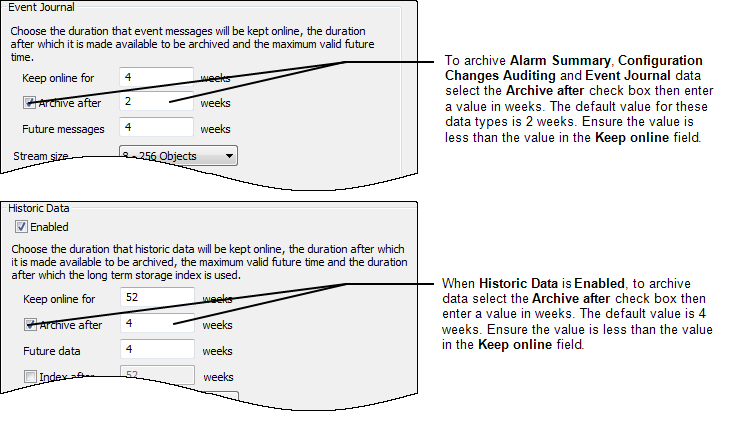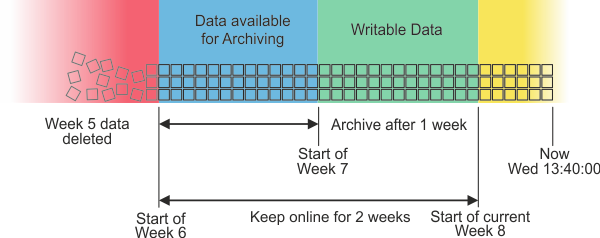Historic data is stored on disk for the specified duration (see Specify the Duration to Retain Historic Data Online), the data is then deleted. During the duration that the data is stored online, the data can be altered (by having new values reported for the time period) unless it is marked as eligible for archiving.
When historic data is marked as eligible for archiving, it can no longer be altered on the disk—the data cannot be written to; it can only be read. When historic data is marked as eligible for archiving, it can be archived for example to CD, DVD and so on, (it has to be archived before the duration of the online data expires).
To enable archiving of historic data and specify the Archive after duration:
- Access the ClearSCADA Server Configuration Tool, (see Accessing the ClearSCADA Server Configuration Tool).
- Expand the Historic Configuration branch.
- Select the historic data type you require,Alarm Summary, Configuration Changes Auditing, Event Journal or Historic Data.
- Select the Archive after check box to allow the selected historic data to be archived. The Archive afternweeks field becomes available.

- In the Archive after nweeks field, enter the number of weeks that have to pass before the historic data is available for archiving. After the Archive after nweeks time has passed, the historic data can be written to a CD, DVD and so on. The time you define applies to both manual and automatic archiving - data can only be archived when it is older than the defined Archive after nweeks time.
NOTE: The Archive after nweeks has to be less than the Keep online number of weeks.
The archiving process can be triggered manually (see Archive Data Manually), or can be set to a schedule (see Set up Scheduled Archiving).
We recommend that you carefully consider the requirements of your system before you define the Archive after nweeks period.
You should use a long period for:
- Systems that have outstations, PLCs and so on, that are out of communications for extended periods
- Systems that have historic data from other sources, such as file uploaded or hand controlled data.
The long periods reduce the chance of data being lost. However, longer periods also mean that the data is not available for archiving as quickly as with shorter periods.
Use short periods on:
- Systems that have outstations, PLCs and so on, that are not expected be out of communications.
For example, a short period could be 1-2 weeks.
Short periods are useful for making data available for archiving more quickly (this reduces the chance of losing data as archiving can occur sooner). However, short periods mean that the writable period is reduced and so any outstations, PLCs and so on, that have been out of communications may only be able to report their data—if the data has a timestamp that is outside the writable time period, the data that is being reported by the outstation, PLC and so on, will not be stored.
Example:
The Keep Online for n Weeks period is set to 2 weeks.
The current time is Week 8: Wednesday 13:40:00, so only the data that was reported after midnight on Monday of Week 6 is included in the Keep online number of weeks period. The data from before midnight on Monday of Week 6 will have been deleted.
The Archive after n Weeks Period is set to 1 week.
The data that was reported between midnight on Monday of Week 6 and midnight on Monday of Week 7 is available for archiving.
The data reported between the start of week 7 and the current time are unavailable for archiving as this data is still writable.

- Apply the changes to the server.